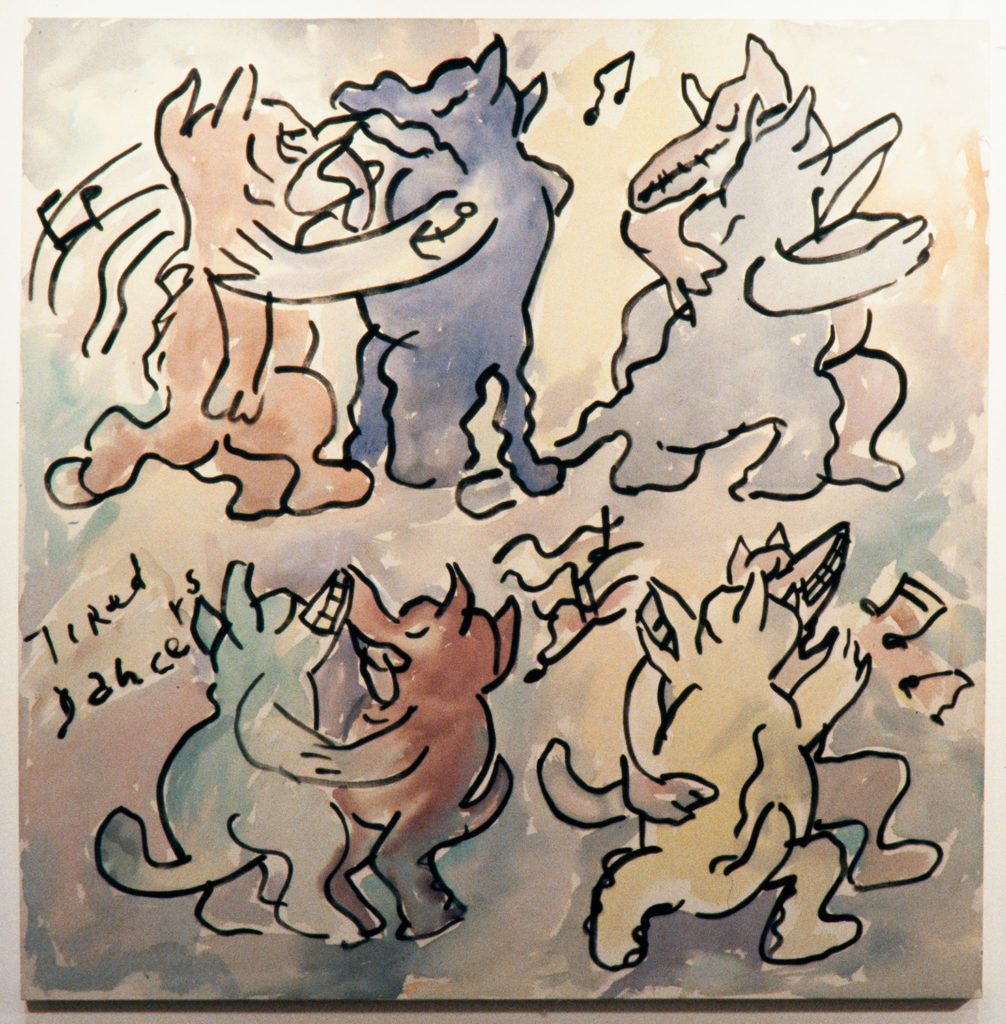ORGANISER Govett-Brewster Art Gallery, New Plymouth OTHER VENUE Govett-Brewster Art Gallery, 31 January—23 February, 1986 PUBLICATION Texts, John Leuthart, Cheryll Southeran
I like art that constantly questions itself, that appears to be aloof, but is passionate, that looks at ordinariness and ordinary things without wishing to colonise them.
—Tom Kreisler.
Not A Dog Show is New Plymouth painter Tom Kreisler's first survey show. The title is a reference to his Dancing Dog paintings, which represent Mexican hairless dogs dancing in different configurations. Kreisler says, 'I thought my paintings haven't gotten a bloody dog show anyway … so I thought it was a good working title for the exhibition.’
Living in New Plymouth, Kreisler is something of an anomaly. His references aren't regional. His paintings abound with 'banal' domestic references, yet also with allusions to global politics, like the Argentine conflict. Born in Buenos Aires, in 1938, Kreisler is the son of Jewish émigré parents. In the early 1950s, after the death of his father, Kreisler—then 13—was sent to live with his aunt and uncle in New Zealand. He later attended Canterbury Art School, studying under Rudi Gopas and Bill Sutton and graduating with Honours. He worked for a number of years as a copywriter, poetry editor, and art reviewer. By 1968, he had a teaching position at New Plymouth Boys High School. He continues to live in New Plymouth and Not A Dog Show first opens at New Plymouth Govett-Brewster Art Gallery.
The earliest paintings are from Kreisler's Coat series , which represent a coat hanging on a wall. They were first shown in 1971 at the Govett-Brewster Art Gallery. Kreisler first painted dye onto stretched canvases, then painted the ‘coat’ in acrylic in bold black outlines over it. The series is a visual pun, riffing on the idea of coats of paint, 'undercoat' and ‘overcoat.'
The show also presents Kreisler’s Weathermap, Baby, and Dancing Dog series, alongside recent paintings influenced by a trip to Mexico. Kreisler's light, wry paintings are described as 'drawings on canvas’. They toy with clichés, translation, and the inanely literal. Concrete Poem is made out of concrete, while Lightness of Hand, Fleetness of Foot finds the phrases scrawled alongside a disembodied arm and foot.
Critic Ian Wedde writes, 'It's the line, the drawing, that makes Kreisler's paintings go. Supple, relaxed, and unworried, it delineates the subjects and imparts movement to them.' Wedde calls the show 'a salute to the provinces,' concluding, 'Not a Dog Show is Kreisler's sardonic title, but I wouldn't mind betting this wag will have his day.’
Govett-Brewster Director Cheryll Southeran describes Kreisler's work as possessing 'the view of an intellectual wanderer whose vision is made both richer and more poignant by his sense of displacement’. Wellington City Art Gallery Director John Leuthart writes, 'This selection of works will provide the first full representative viewing and appraisal of Kreisler's work outside New Plymouth.'
New Plymouth remained Kreisler's base for the rest of his life. He died of a heart attack in 2002, aged 63. In 2007, his son Aaron Kreisler curated a touring survey show in conjunction with the Govett-Brewster Art Gallery, and, in 2015, Shirley Horrocks released the documentary Tom Who?: The Enigma of Tom Kreisler. She said, 'I was shocked that he wasn't included in the mainstream canon of New Zealand art. I would like to get this guy better known.'



























































